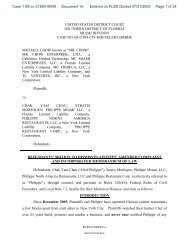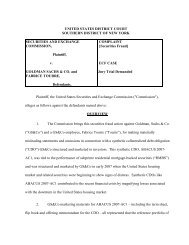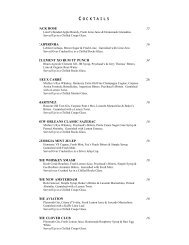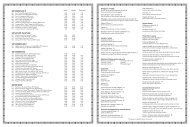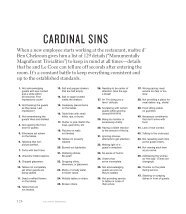PART 35 - Nymag
PART 35 - Nymag
PART 35 - Nymag
Create successful ePaper yourself
Turn your PDF publications into a flip-book with our unique Google optimized e-Paper software.
inotion should be rejected by the Court. Since the underlying alleged conduct of Burrell clearly<br />
fails to establish “the required threshold of interolerability,” Hennigan’s providing of two (2)<br />
weeks’ notice of her resignation further establishes that said claims are insufficient. Tlie<br />
Coniplaint is also devoid of any allegations that defendants specifically engaged in such conduct<br />
in oi-der to ti-y to force Heiinigan to quit.<br />
4iialysis<br />
111 determining a motion to dismiss, the court’s role is ordinarily limited to determining<br />
- -- -- -<br />
--<br />
wlietlier tlie coinplaint states a cause oTaction (Frank v D)aiinlerChrys/er Corp., 292 ADXTTK- ~ ~ - ~<br />
741 NYS2d E) [ 1st Dept 20021). The standard on a motion to dismiss a pleading for failure to<br />
stdc a cause of action is not whether the party has artfully drafted the pleading, but whether<br />
deeming the plcading to allege whatever can be reasonably implied from its statements, a cause<br />
of action can be sustained (see Stendig, Inc. v Thorn Rock Realty Co., 163 AD2d 46 [ 1st Dept<br />
19901; Leviton Munufacturiiig Co., hc. v Blumberg, 242 AD2d 205, 660NYS2d 726 [ 1st Dept<br />
19971 [on a inotion for dismissal for failure to state a cause of action, the court must accept<br />
ractual allegations as true]). When considering a motion to dismiss for failure to state a cause of<br />
action, the pleadings must be liberally construed (see CPLR $3026), and the court must “accept<br />
the facts as alleged in the complaint as true, accord plaintiffs the benefit of every possible<br />
favorable inference, and determine only whether the facts as alleged fit into any cognizable legal<br />
theory” (No~rnon v City ojNew York, 9 NY3d 825 [2007]; Leon v Martinez, 84 NY2d 83, 87-88,<br />
61 4 NYS2d 972 [ 19941). However, in those circumstances where the bare legal conclusions and<br />
factual allegations are “flatly contradicted by documentary evidence,” they are not presumed to<br />
be true or accorded every favorable inference [Biondi v Beekman Hill House Apt. Corp., 257<br />
18



